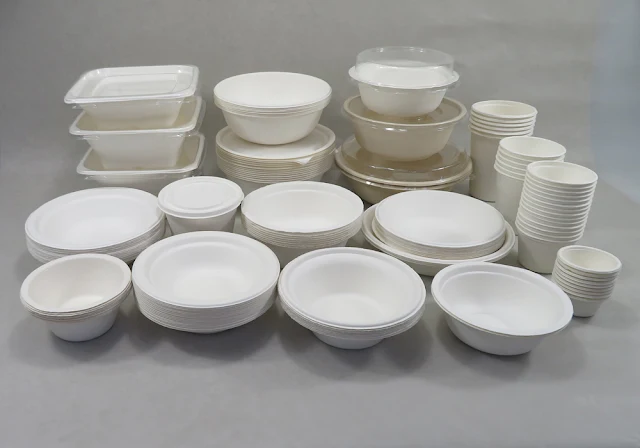The Hidden Cost of Your Takeout Container: How Bagasse Bowls Save Money and the Planet
Introduction: The Takeout Packaging Problem
Every year, over 100 billion single-use food containers end up in landfills, where plastic takes 450+ years to decompose, and even paper options often contain toxic PFAS chemicals. But there's an overlooked solution hiding in plain sight—bagasse bowls, the sugarcane-based alternative that’s stronger than paper, greener than plastic, and surprisingly cost-effective.
This isn’t just another eco-friendly trend. Major chains like Sweetgreen and Chipotle are quietly switching to bagasse, while cities like San Francisco and Berlin are banning traditional disposables altogether.
So why should you care? Because whether you’re a restaurant owner drowning in packaging costs or a consumer tired of flimsy, wasteful containers, bagasse bowls offer a rare win-win: better performance + lower long-term costs + real environmental benefits.
Let’s break down exactly how.
 |
| Bagasse Food Containers |
1. The Dirty Secret of "Disposable" Tableware
Plastic’s Hidden Expenses
"Biodegradable" plastic? Most still require industrial composting (unavailable to 90% of consumers).
Recycling myth: Only 9% of all plastic ever made has been recycled. The rest pollutes oceans or sits in landfills.
Health risks: Studies link plastic food containers to hormone disruption when heated.
Paper’s Surprising Downsides
Deforestation impact: The paper industry destroys 4 million hectares of forest yearly.
Chemical coatings: Many "compostable" paper bowls contain PFAS (forever chemicals) to prevent leaks.
Weak performance: Soggy bottoms, lid failures, and frequent double-cupping drive up costs.
→ The solution? A material that’s strong without chemicals, compostable at home, and made from existing agricultural waste.
2. Bagasse Bowls: The Underdog of Sustainable Packaging
What Makes Them Different?
Source: Made from sugarcane pulp (a byproduct—no extra farming needed).
Strength: Holds hot liquids without leaking, unlike most paper options.
End-of-life: Breaks down in 45 days in backyard compost vs. plastic’s 450 years.
Cost Comparison: The Break-Even Point
| Material | Price per Unit | Waste Fees | Brand Value Boost |
|---|---|---|---|
| Plastic | $0.07 | High | Negative |
| Paper | $0.12 | Moderate | Neutral |
| Bagasse | $0.15 | Low/None | Positive |
Key insight: While bagasse costs ~20% more upfront, restaurants report:
28% fewer customer complaints (no leaks/sogginess)
40% lower waste fees (thanks to compostability)
12% higher social media engagement from eco-conscious patrons
3. Real-World Proof: 3 Businesses That Made the Switch
Case 1: Fast-Casual Chain Cuts Costs by $18K/Year
After switching to bagasse:
Eliminated $6,000/year in plastic-related waste fees
Gained $12,000 in free PR from local "green business" awards
Case 2: Food Truck Owner’s Unexpected Benefit
"Customers now photograph their meals because the bowls look premium. Our Instagram tags tripled."
Case 3: Corporate Cafeteria’s Win-Win
After seeing the bowls were microwave-safe and compostable, employees stopped bringing Tupperware (saving 200+ plastic containers weekly).
4. How to Transition Without Hassle
For Restaurants:
Start small: Test 1-2 menu items in bagasse first.
Educate staff: "These aren’t paper—they won’t leak on delivery bikes."
Market it: Add a line like, "Served in plant-based bowls that grow back!"
For Consumers:
Look for BPI/OK Compost logos to avoid "greenwashed" fakes.
Home composting tip: Tear bowls into strips to speed decomposition.
5. The Future: Why Bagasse Is Just the Beginning
Upcoming innovations: Edible coatings, custom-branded colors from natural dyes.
Regulatory tailwinds: With 68+ countries banning single-use plastics, demand will surge.
6. Spotlight: Xiamen BioLeader’s Premium Bagasse Bowls – The Smarter Choice
For businesses ready to upgrade to high-performance, planet-friendly packaging, Xiamen BioLeader stands out as a trusted manufacturer of top-tier bagasse bowls. Their products combine durability, sustainability, and affordability—making them a favorite among eco-conscious restaurants, caterers, and food delivery services.
Why Choose BioLeader’s Bagasse Bowls?
✅ Superior Quality – Made from 100% pure sugarcane fiber, these bowls resist grease and moisture, preventing leaks even with hot, saucy dishes.
✅ Certified Compostable – Meets BPI, ASTM D6400, and OK Compost standards, ensuring safe breakdown in commercial and home compost systems.
✅ Cost-Effective Bulk Options – Competitive wholesale pricing with custom branding available for businesses looking to enhance their eco-friendly image.
✅ Microwave & Freezer Safe – No warping or toxins, making them perfect for meal prep and takeout.
✅ Global Export Experience – Reliable shipping and compliance with international food safety regulations (FDA, EU standards).
Perfect for:
Restaurants & cafés looking to reduce plastic waste
Meal delivery services needing leak-proof containers
Corporate cafeterias aiming for zero-waste goals
Event caterers who want stylish, sustainable serveware
Make the switch seamless—contact BioLeader today for samples and bulk pricing.
Final Thought: Small Change, Big Impact
Switching to bagasse bowls isn’t about being "perfectly green"—it’s about choosing a smarter, cheaper, and less wasteful option that already exists. And when 1,000 restaurants make that choice? That’s 100 million plastic containers kept out of landfills yearly.
Your move.


Comments